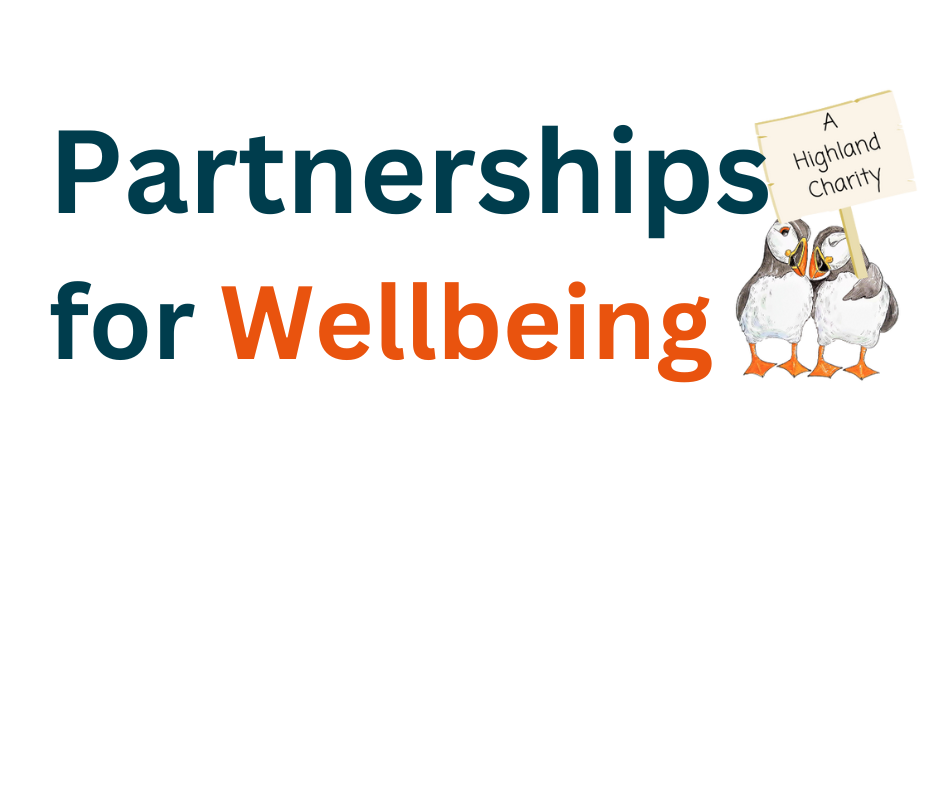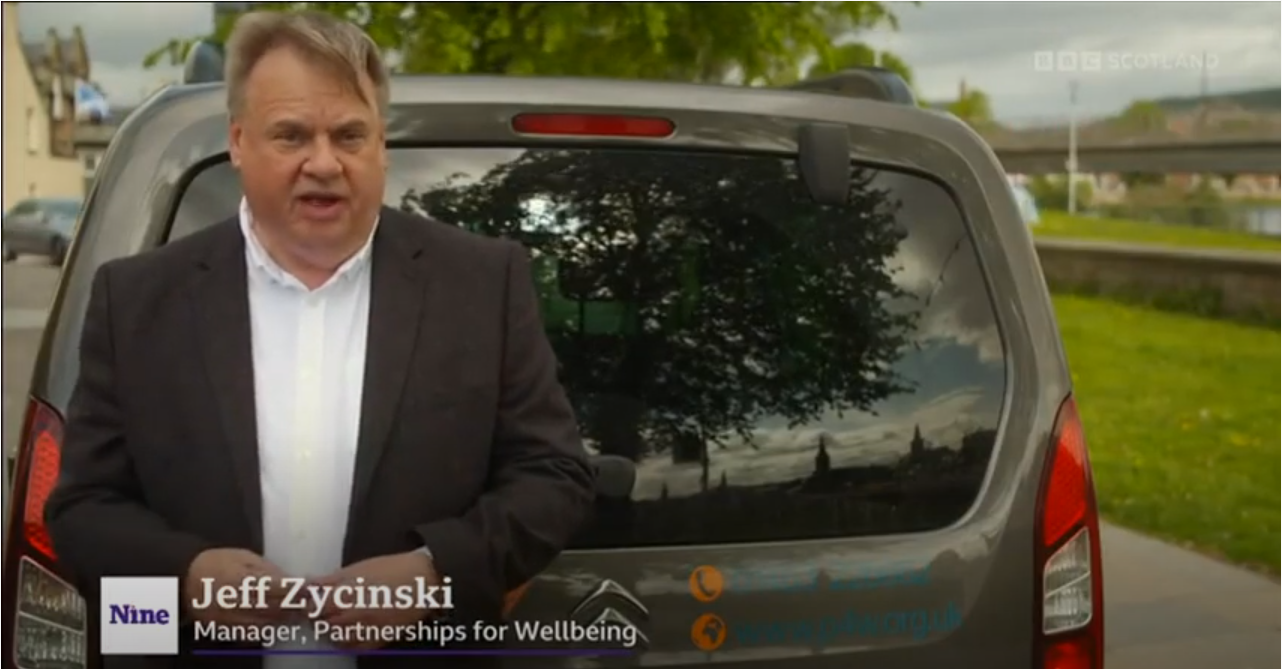Making headlines with our new WAV.
Partnerships for Wellbeing was making headlines. BBC reporter Isla Todd included us in her story about the scarcity of wheelchair accessible taxis in Inverness. Here’s a link to the story as it featured on television.
Driving Change
Millie Fuller writes about the Partnerships for Wellbeing charity in Inverness and the importance of its community transport service.
Millie Fuller
Our guest writer Millie Fuller offers seven good reasons why community transport should be considered an important service.
Driving Change: The Impact of Community Transport
People need to travel to use local services, engage in their community, and be independent. But this can be difficult for some. For example, older adults and those with disabilities. Accessing public transport can be stressful as it's not reliable. Furthermore, not everyone can drive or afford a taxi. This leads to a 'transport gap' or disadvantage.
Community Transport aims to help those who have difficulty using public transport. This service is not-for-profit and relies on volunteers. It picks people up from their homes and takes them to and from their destination. It's particularly helpful for those who don't have other options.
Accessibility
Getting to a bus stop or train station can be difficult or impossible for some. With community transport, this isn't a worry. Instead, they can book a door-to-door ride in advance, including wheelchair-accessible minibuses. Volunteers can also help with getting in and out, making it more convenient and accessible than public transport.
Safety
Clients may take comfort in knowing that drivers aren't only there to drive, but to help. Also, extra safety measures, like masks and ventilation, are easier to put in place.
Affordability
Community transport is relatively affordable. It's similar in cost to public transport and considerably cheaper than taxi services.
This cost-efficiency extends to the economy. By lessening demand for Patient Transport Services it reduces the onus on the NHS.
Social connection
In the UK, many older people often feel lonely - as many as 1.4 million according to Age UK.
Not having social connections affects everyone's lives, with unhealthy habits worsening the subsequent depression and anxiety. Furthermore, older adults who are lonely need more care from family and services.
According to a survey by the Scottish government, 69% surveyed used community transport just to get out of the house. This helps to improve their wellbeing by getting them to social activities.
There's also the advantage of getting to know the driver and passengers on journeys. This can make it something to look forward to. Thus, it's more than just a journey from point A to B. It's an opportunity to make friends. Volunteer drivers also gain personal satisfaction from the job.
Personalised care
Drivers often go the extra mile. For example, helping to carry shopping bags. They regularly see users, and so, can be attentive to early signs of problems. This caring and watchful approach can prove invaluable.
Independence
People can't enjoy their lives while worrying about how to get to about. Community transport can help them be independent. In the case of older adults, this reduces the need for nursing and residential care. The previously mentioned survey found that 89% agreed it's important for their independence.
Furthermore, access to doctors means people are diagnosed and treated earlier. This means better prognoses and lower mortality rates.
Millie Fuller describes herself as a budding writer with a love of coffee who pens pieces about topics close to her heart.
Listen to our new podcast!
We’ve started a podcast! In this episode we have comedian Raymond Mearns joining Jeff, Nicola and Kate to chat about how to be perfectly imperfect and his new show, ‘Everyone hates Raymond’ coming to Eden Court in Inverness on March 12th 2022.
It’s in the bag
Like many of you, we here at Partnerships for Wellbeing had to cancel or postpone a few of our planned festivities because of the latest Covid alert. The first casualty was our Valued Volunteers party where we had hoped to bring together all our drivers, walk leaders and board members – many of whom have never met each other. Well that knees-up is on hold until, we hope, February next year. One very sweet problem we encountered was what to do with the fifty small party bags of tablet that Nicola MacKenzie, our transport officer, lovingly prepared just 24 hours before we decided to follow Government guidelines and change our plans. Nicola, a culinary perfectionist, doesn’t think it will keep until February. I’ve offered to eat the lot myself, but instead we’re gifting it to our friends and neighbours. Well, most of it. Meanwhile, I’m adding Nicola’s recipe for Puffin Tablet at the end of this blog entry. And if you watch the Christmas edition of Ways to Wellbeing, you’ll see how we came up with a tortured and convoluted way of arguing that making and gifting tablet can fulfil all five of the NHS Steps to Wellbeing. Ok, we may be kidding ourselves, but its worth a try.
JZ
Puffin Tablet
Makes approx 90 1x1” squares.
What you’ll need:
- 250ml Full Fat Milk
- 900g Caster Sugar
- 85g Butter
- 1 x Tin of Condensed Milk (400g tin)
- 9x13inch dish
- Thermometer*
- A strong arm… there is a lot of whisking ahead!
*If you don’t have a thermometer, have a small cool plate ready.
Method:
1.Grease and line a 9x13inch deep tray. Have a whisk or wooden spoon, thermometer & your tray to hand. As the tablet sets quickly, it’s best to have everything prepped in advance.
2. Add your milk, sugar + butter to a large heavy-based pan and place on a medium heat until everything is combined, and the sugar has dissolved. Stir constantly.
3. Add your condensed milk to the pan and continue to stir thoroughly.
4.Increase the heat slightly, bringing the mixture to a gentle rolling boil. Stir continuously.
5.You’ll see the mixture begin to darken in colour. Patience is paramount – this process can take around 45minutes. You’re looking for a deep, rich golden colour. Your mixture, when ready, should reach 120⁰ϲ. If you don’t have a thermometer, place a spoonful of water on a cool plate. Carefully, drop a small amount of mixture into the water. The tablet is ready when it can easily be formed into a smooth ball. 6.Take the pan off the heat and continue to whisk the mixture for another five minutes. You should see it begin to thicken slightly.
7.Carefully pour the mixture into the prepared dish, ensuring it has been spread across the dish evenly.
8. Allow the tablet to set at room temperature. After 20 minutes, gently score the tablet into squares for easy cutting later. Leave the tablet to set fully, for at least one hour.
9. Cut the tablet into squares and store in an airtight container for up to 2 months… if it lasts that long!







